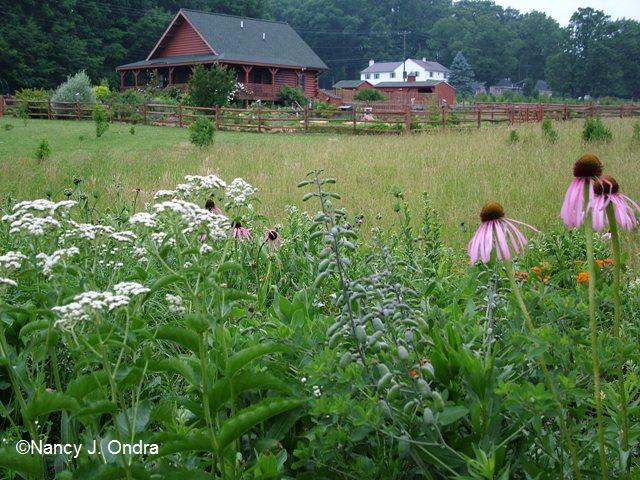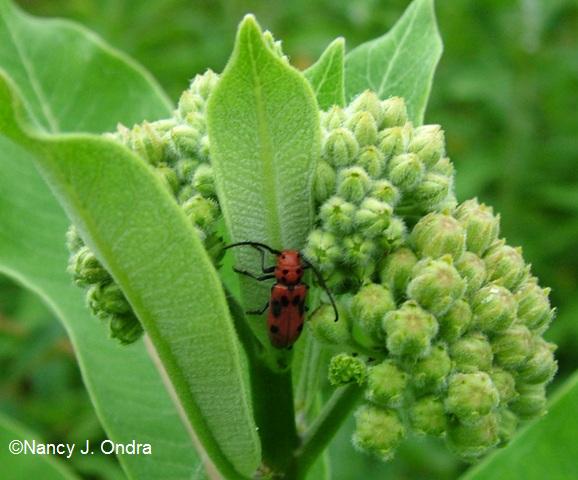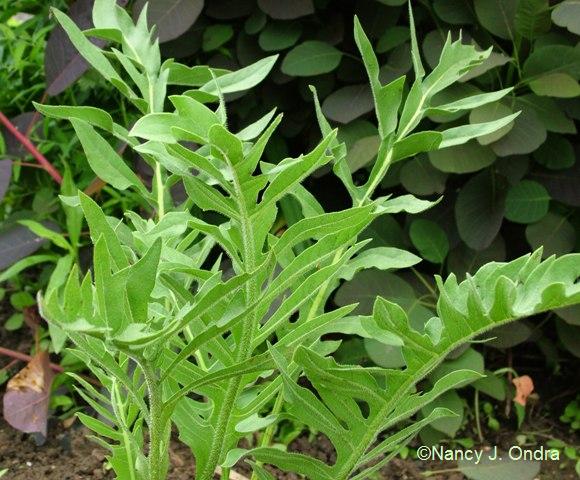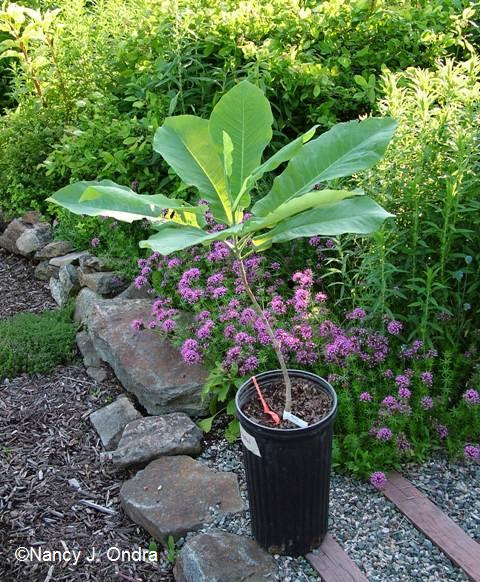In Part One, I covered some highlights of the first day of the Native Plants in the Landscape Conference, which was held at Millersville University in Millersville, PA from June 4 through June 6. Here are some more of my notes and ramblings from the other two days (again, lots of text and not many photos; sorry!).
Treasures Among Our Natives (Doug Tallamy)
Dr. Tallamy, as many of you know, is the author of Bringing Nature Home and Chair of the Department of Entomology and Wildlife Ecology at the University of Delaware. When he spoke at the conference a few years ago, I was entranced by his explanations of why, specifically, it was so important to include native plants in our gardens and landscapes. I remember thinking, though, that it would be tough to convince many gardeners to choose plants specifically as food for insects. People who get agitated about a few chewed leaves here and there just aren’t going to buy into planting stuff that they know will attract all kinds of “nasty pests.” Maybe I’m wrong about that; I hope so.
I was intrigued to find out that the premise of his lecture this time was less on the conservation value and more on the “entertainment value” of planting natives: the entertainment coming from learning about and observing the habits of various insects. If every doubtful gardener could hear Dr. Tallamy’s great stories and passion for the subject, I’m sure they’d be swayed into planting more natives, and into changing their gardening practices to protect and support native insects. A few notes:
- He spent a good bit of time talking about the various insects that feed on milkweeds, and how they’ve adapted to deal with the milky sap. Monarch larvae travel down to the leaf tip and then start to feed; if sap comes out, they turn around and go back up partway, then bite the midrib to stop the sap from flowing. Then, they can eat without getting their mandibles glued shut with the sap. This causes the leaves to “flag,” or bend over, at the bite point, so you can tell from some distance if larvae are (or had been) feeding on the plant.
- Milkweed beetles have a similar tactic, but their mouthparts are smaller, so they have to make many smaller bites in the midrib.
- Milkweed bugs feed on the seedpods. They stick their mouthparts into the pod and release saliva to liquefy the developing seeds to they can suck up the liquid. The process works best when many of the bugs are feeding in one spot, so you usually find them in large groups. It’s not a big problem for the milkweeds, though, because the bugs’ mouthparts are short, so only the outermost seeds are affected; the inner ones can still mature normally and drift away to start new plants.
- Oaks are also very valuable for native insects. As a group, oaks have one of the widest (or maybe it was the widest?) geographical distribution of any woody plant genus (I hope I got that right). Their full life span is about 900 years (300 years of growing, 300 years of stasis [surviving], and 300 years of senescence [dying]). Over that time, a single oak can produce about 3 million acorns. Their success in spreading is due to their close association with jays, which use acorns as their main winter food. After collecting an acorn, a jay flies about 2 miles before burying it in the ground with its beak. It retrieves only about 1 in 4 of the acorns its buries, leaving the other three to potentially sprout into new oaks.
- Almost every acorn you find (over 90 percent of them) will have a small hole in it, which is a sign that it contains an acorn weevil grub. The presence of the grub doesn’t interfere with germination, though, and it provides extra protein for critters who eat the acorns.
- Fireflies need leafy debris to develop in, so you can provide habitat for them by using leaf mulch instead of shredded bark. Edging wooded properties with beds of ferns is a good way to keep dropped leaves from blowing away into the neighbors’ yards.
- As most of you know, gypsy moth infestations can be devastating, but spraying with even the “natural” control BTK kills the larvae of all lepidopterans (moths and butterflies), so it takes the good with the bad. There is a naturally occurring virus that targets only gypsy moth larvae, and it is produced in small quantities by the U.S. Forest Service under the name Gypcheck. It is not commercially available, however, apparently because there is no profit in producing it? Seems like someone should be able to figure out how to make money by selling it commercially!
- Another topic was the story of certain kinds of lace bugs that feed primarily on horse nettle plants. They’re one of the few critters that tend their young until maturity, and the ways they do that are really fascinating (including the ways that some females hang out to mind the day care while others go off and dump their eggs on other stay-at-home moms). To get the full story, check out this article by Dr. Tallamy: Child Care among the Insects.
- There are lots of ways insects use mimicry to keep from being eaten by birds: by looking like bird droppings or snakes, or by resembling leaf edges (so the birds don’t notice chewed leaves and stop in to look for food). Some syrphid flies closely resemble yellow jackets in looks and in their buzzing sound, while robber flies resemble bumblebees.
- Someone asked Dr. Tallamy his opinion on whether it was okay to plant hybrids or cultivars of native plants. His response was that it’s probably fine to plant selections of native plants, unless they’ve been chosen for unusual flower colors or flower forms (some of those poofy echinaceas come to mind) , which could affect how insects find and/or feed on them. Hybrids, on the other hand, are more likely to have significant changes in leaf chemistry, which could make them less desirable food for native insects.
- Want to know which natives provide food for the most native moths and butterflies? Check out Dr. Tallamy’s web site, Bringing Nature Home.
From Concrete Scraps to Gnomes – Fun, Sustainable Touches for Your Native Plant Garden (Angela Treadwell-Palmer)
A few notes:
- Love the classic look of wrought iron but can’t afford it? Paint your trellises, containers, and other structures and ornaments with flat black paint to get a similar look.
- Silliest garden accent of the talk: Gnome-Be Gones, available through the Uncommon Goods catalog. Check out their other garden offerings, too; some of them are really fun (a few of my favorites were the Stone Soup Kit, the Can’t Get Enough of Your Glove vase, and the Flamingo-Away sculpture).
Field Trip to Shenk’s Ferry (Tim Draude)
Shenk’s Ferry Wildflower Preserve is famous for its trilliums and other spring wildflowers (there’s a good story here at PA Elsewhere). Unfortunately, we were too late in the season to see much of anything in bloom. A few notes:
- Botanizing with a botanist is always an oppotunity to treasure, even in the rain. Botanizing with people carring umbrellas, however, is perilous to those without them. I suggest wearing safely glasses or – better yet – staying as far away from the umbrella-wielders as possible.
- On the way back, I had an interesting chat with a fellow attendee about rose rosette disease. I shared my experiences with RRD on my garden roses, and he said that he’s seen affected multifloras actually killed by the disease (I was beginning to wonder if that really happened, because the plants in the wild around here just seem to look bad).
The Hidden World of Mycorrhizal Fungi (Dr. Roger Tai Koide)
Wow, a fantastic talk. Dr. Koide, Professor of Horticultural Ecology at Penn State University, made what could have been a dead-boring topic into a funny and fascinating presentation, though the humor won’t come across in my rather straightforward notes. Some of this information I’d heard before, but other parts were new to me; it answered some of my questions and led to others that I plan to follow up on as time allows. Some notes:
- Mycorrhizal fungi (fungi that live in association with plant roots) are biotrophic, which means that they get their nutrition from living material. (Saprotrophic fungi feed on dead stuff.) The fungi get carbohydrates from the plants, and the plants get minerals from the fungi.
- Most plants are associated with some kind of mycorrhizal fungi. Ectomycorrhizal fungi stay just outside of the roots; they’re associated with many kinds of trees and are especially common in large expanses of forests. Most herbaceous plants are associated with arbuscular mycorrhizae. (Some woodies – including cherries and other rose-family relatives, leguminous species, maples. dogwoods, and tulip populars, among others – have this kind too.) Arbuscular mycorrhizae, a type of endomycorrhizae, live inside roots and store energy in the form of lipids (oils) in structures called vesicles. Dr. Koide showed a brief video of a spore of this type of fungus germinating, seeking out a root, and entering a root cell without any response from the plant. (If a “bad” fungus had entered, the plant would have responded by killing off some of its own cells in an effort to keep out the intruder.
- Arbuscular mycorrhizae can associate with many different plants, while some ectomycorrhizae are associated only with certain plants. Ericaceous plants (rhododendrons, azaleas, blueberries) have a specific kind of mycorrhizae; so do orchids.
- Mycorrhizae send “hyphae” out into the soil, greatly increasing the surface area for absorbing water and nutrients. Most phosphorus is taken up by mycorrhizae first, then the excess is given to the plants they’re associated with. Overapplying phosphorus to the soil may limit colonization by mycorrhizae.
- In fields that are left fallow (unplanted) over the winter, the mycorrhizae begin to die off, because there are no live roots for them to associate with. They re-establish themselves after spring planting, but it takes a while. Planting fields with cover crops for the winter, and then planting the regular crop through the cover crop in spring, makes them significantly more productive, because the mycorrhizae are already in place and active early in the growing season. (Seems like this would apply to home vegetable gardens and flower beds as well.)
- Different types of mycorrhizae are active in in different seasons, at different moisture levels, and in different soil types (sandy versus clayey soil, for example). Mycorrhizae generally aren’t active in soggy soil.
- All woody plants have some sort of mycorrhizal association, and so do many herbaceous plants. Only a small fraction of plants don’t have any mycorrhizal associations. Some plants that don’t associate with mycorrhizae include members of these families: Caryophyllaceae (dianthus, gypsophila), Gentianaceae (gentians), Brassicaceae (mustard, cabbage, broccoli), Chenopodiaceae (beets, chard, spinach), Crassulaceae (sedums and other succulents), and Cyperaceae (sedges).
- Mustard-family plants get their phosphorus by secreting acids into the soil to solubilize the phosphorus. Mustard oils discourage the development of mycorrhizal fungi. Just one season of growth of garlic mustard can kill the mycorrhizae in the soil around its roots.
- Is it worth buying mycorrhizae for your garden? His conclusion is, basically, it’s not. Garden plants who need mycorrhizae already have them (or they’d be dead). Arbuscular mycorrhizae are present unless the soil is extremely disturbed or has been growing mostly mustard-family plants for many years. Most commercial products contain fertilizer (which can account for slightly improved growth); the actual fungi may be limited or dead. Another issue is that we don’t yet know the consequences of moving non-native fungi around.
PLANT SALE!
And finally, perhaps the best part of this conference: one of the best sales of native plants that you can find anywhere. Over 20 vendors offer a thrilling diversity of natives at amazingly reasonable prices. The sale, which is also a popular area for socializing, is open to attendees only for the first two days, then open to the public too on Saturday. Some of the vendors live nearby and restock several times during the three days, so it’s worth making the rounds many times. I really hadn’t planned to buy anything (uh huh), but I ended up with two more pots of pawpaw (Asimina triloba). I bought them before the Shenk’s Ferry trip, where we saw the plants growing wild on damp, shady slopes; after that, I wondered why I keep trying to grow them when I can’t offer them any shade.
A more unusual find was a cup plant with outstanding foliage: Silphium pinnatifidum. The leathery, deeply lobed leaves of a larger pot, especially, looked much like some kind of philodendron. I went for the smaller pot and hope to enjoy a similarly large clump in a few years. (Heaven knows that S. perfoliatum certainly thrives here!)
And finally, a friend insisted that a beautiful Magnolia ashei really needed to come live with me. I’m not all that excited by magnolias in general, but he convinced me that it was really wonderful, and the huge leaves were quite interesting. It’s one of the rarest magnolias in North America, native to just a few counties in the Florida panhandle, but I’m assured that it’s hardy even to Zone 5, so I’ll keep my fingers crossed. Trees that I’ve bought from Go Native Tree Farm at past conferences have done very well, so I have every hope that this one will succeed too.
By this point, you’re probably very relieved that I skipped the last session I had signed up for, on rain gardens. I was ready to get home and get back into my garden. Speaking of which, it’s finally stopped raining here in southeastern PA, so I’m ready to get out there again!




